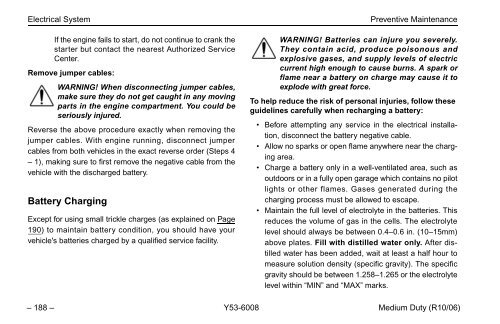Peterbilt Medium Duty Trucks Operator's Manual after 1-07
Peterbilt Medium Duty Trucks Operator's Manual after 1-07
Peterbilt Medium Duty Trucks Operator's Manual after 1-07
You also want an ePaper? Increase the reach of your titles
YUMPU automatically turns print PDFs into web optimized ePapers that Google loves.
Electrical System<br />
If the engine fails to start, do not continue to crank the<br />
starter but contact the nearest Authorized Service<br />
Center.<br />
Remove jumper cables:<br />
WARNING! When disconnecting jumper cables,<br />
make sure they do not get caught in any moving<br />
parts in the engine compartment. You could be<br />
seriously injured.<br />
Reverse the above procedure exactly when removing the<br />
jumper cables. With engine running, disconnect jumper<br />
cables from both vehicles in the exact reverse order (Steps 4<br />
– 1), making sure to first remove the negative cable from the<br />
vehicle with the discharged battery.<br />
Battery Charging<br />
Except for using small trickle charges (as explained on Page<br />
190) to maintain battery condition, you should have your<br />
vehicle's batteries charged by a qualified service facility.<br />
Preventive Maintenance<br />
WARNING! Batteries can injure you severely.<br />
They contain acid, produce poisonous and<br />
explosive gases, and supply levels of electric<br />
current high enough to cause burns. A spark or<br />
flame near a battery on charge may cause it to<br />
explode with great force.<br />
To help reduce the risk of personal injuries, follow these<br />
guidelines carefully when recharging a battery:<br />
• Before attempting any service in the electrical installation,<br />
disconnect the battery negative cable.<br />
• Allow no sparks or open flame anywhere near the charging<br />
area.<br />
• Charge a battery only in a well-ventilated area, such as<br />
outdoors or in a fully open garage which contains no pilot<br />
lights or other flames. Gases generated during the<br />
charging process must be allowed to escape.<br />
• Maintain the full level of electrolyte in the batteries. This<br />
reduces the volume of gas in the cells. The electrolyte<br />
level should always be between 0.4–0.6 in. (10–15mm)<br />
above plates. Fill with distilled water only. After distilled<br />
water has been added, wait at least a half hour to<br />
measure solution density (specific gravity). The specific<br />
gravity should be between 1.258–1.265 or the electrolyte<br />
level within “MIN” and “MAX” marks.<br />
– 188 – Y53-6008 <strong>Medium</strong> <strong>Duty</strong> (R10/06)
















